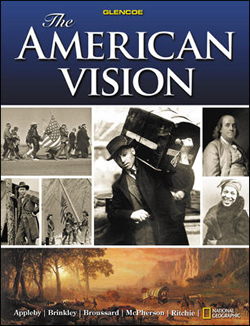The American Vision © 2008Chapter 17:
The Jazz AgeWeb Lesson PlansIntroduction
Students have read about the African American literary and artistic movement
that came to be known as the Harlem Renaissance. In this activity students
will research the people who lived in Harlem and produced the works of the
Harlem Renaissance.
Lesson Description
Students will use information from the Harlem 1900–1940 Web site to learn
about the important figures of the Harlem Renaissance. Students will read about
activists, businesspeople, artists, community leaders, sports players, writers,
and intellectuals. The site also provides photos and a time line of events.
Students will then answer four questions and apply this information by writing
a short essay that describes how the Harlem Renaissance impacted American culture.
Instructional Objectives- Students will identify several important figures of the Harlem Renaissance
and describe how their works impacted American culture.
- Students will be able to use this knowledge to write a short essay that
describes the impact of the Harlem Renaissance on the art, music, and literature
of American society.
Student Web Activity Answers- in northern Manhattan, in New York City
- Authors and works include Langston Hughes, The Negro Speaks of Rivers; Claude
McKay, If We Must Die and Home to Harlem; and Zora Neale Hurston, Dust Tracks
on the Road and Their Eyes Were Watching God.
- Aaron Douglas, "Into Bondage"; William H. Johnson "Self-Portrait with Bandana"
- As a jazz innovator, Duke Ellington blended African and Latin elements into
a new sound. His special effects and new instrumentation made his music widely
popular. His contributions to jazz still influence music today.
- Students' short essays will vary.
 | 




